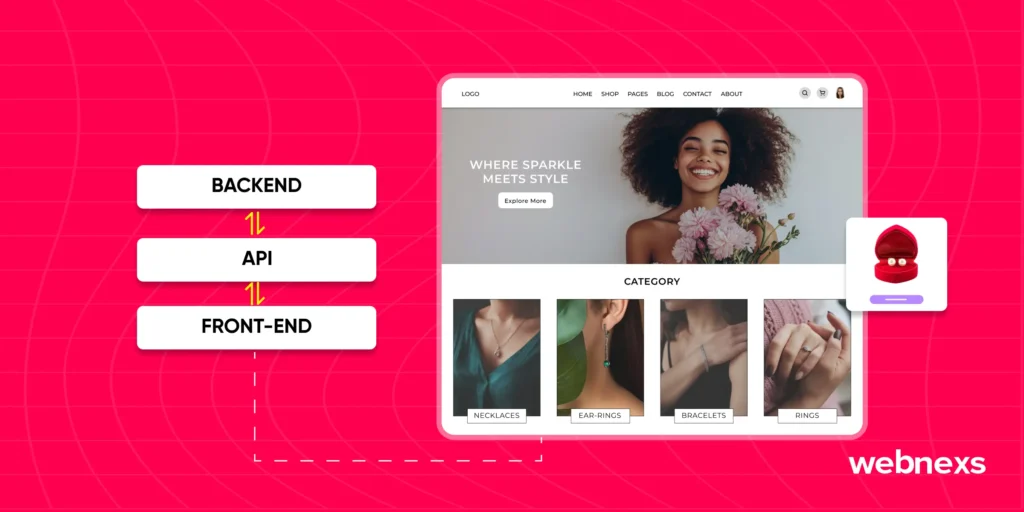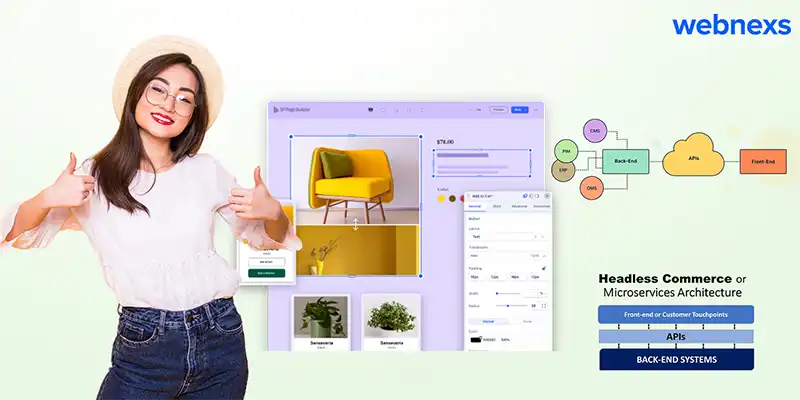Hello, Insight Hunters!
As ecommerce evolves, flexible architectures like headless and microservices are driving success, with the headless commerce market expected to grow from $1.7 billion in 2020 to $5.6 billion by 2025, and 47% of enterprises already adopting microservices for faster development and enhanced user experiences.
Staying ahead in the competitive world of ecommerce requires quickly embracing new technologies.
The technology behind the scenes, such as headless commerce, ensures a seamless and engaging user experience key to achieving success.
The foundation of an ecommerce platform is its architecture, with flexibility playing a vital role in distinguishing the best platforms.
Headless architecture vs microservices architecture are two common approaches contributing to the success of many platforms. While they share some similarities, they operate and are built differently.
This blog explores the key differences between headless architecture and microservices architecture and how combining them can drive better business decisions.
Key Takeaways on Headless Architecture vs Microservices Architecture
- Microservices vs headless: Microservices split the back end into smaller services, while headless separates the front end from the back end, giving more control on both areas and flexibility.
- Headless software architecture lets businesses update the front end without touching the back end, offering more freedom to create unique and tailored customer experiences.
- Microservice architecture lets companies grow quickly by dividing the back end into smaller, independent parts. This makes it easier to manage and upgrade each component separately.
- Combining microservices with headless architecture helps businesses stay flexible, enabling faster updates and personalized experiences while keeping up with market changes.
- By using both approaches, businesses can build platforms that are more adaptable and scalable, giving them an edge in today’s fast-moving digital landscape.
Scale Faster with Headless Architecture
Key Differences Between Headless Architecture vs Microservices Architecture
The debate of headless architecture vs microservices architecture is crucial for businesses. Understanding headless commerce vs microservices can help optimize ecommerce platforms. The following table compares their key features for better decision-making.
| Feature | Headless Architecture | Microservices Architecture |
| Architecture | A single back-end serves content through APIs to various front-ends using RESTful or GraphQL. The decoupled structure allows for managing and storing content in the back-end without interfering with the front-end technology. | A collection of loosely coupled and independently deployable services that manage processes without affecting one another. |
| Scalability | Facilitates independent scalability to serve different platforms more easily; the front-end can be scaled horizontally due to the decoupled nature. | Individual services can be scaled independently based on demand, allowing easy scaling of parts under heavy loads without affecting others. |
| Complexity | Less complex but can become complex when managing various front-ends or integrating different systems through APIs. | Inherently complex due to the need for designing, deploying, and maintaining multiple independent services; communication and data consistency can be challenging. |
| Service Structure | Typically monolithic at the back-end but can serve multiple front-end applications; the focus is on Content Management Systems (CMS) or the ecommerce platform. | Each microservice is an independent unit handling specific functionalities of the ecommerce platform. |
| Communication | Communication occurs only between front-end and back-end through APIs (REST or GraphQL); no inter-service communication within the back-end. | Communication takes place over APIs (REST or gRPC) or message queues; service communication is key to maintaining overall system functionality. |
| Database | Utilizes a centralized, single database to store content and support multiple front-end channels. | Employs a decentralized database structure following the ‘database per service’ principle for flexibility and fault isolation. |
| Deployment | Deployed as a single system to handle back-end and API services for different front-end applications, focusing on the separation of front-end and back-end. | Allows for independent deployment using separate servers, containers, and cloud services for each microservice, enabling continuous delivery and independent scaling. |
Choosing Between Headless Commerce and Microservices for Your Online Business

When comparing microservices architecture and headless architecture, it’s important to understand their different roles in modern ecommerce setups. Headless architecture separates the front end (what customers see) from the back end (how everything works behind the scenes), allowing businesses to create highly customizable and seamless experiences across different platforms.
Microservices, in contrast, divide the backend into smaller, separate services that can function independently. This approach offers more flexibility, scalability, and the ability to make changes to one part of the system without disrupting the whole thing.
Headless architecture, on the other hand, is all about giving businesses more control over the front-end experience for customers, while microservices focus on streamlining and organizing the backend to improve efficiency.
If a business wants to offer a highly customized experience for users, headless is a good choice. But if the focus is on building a scalable backend that can handle separate services, microservices may be a better fit. In many cases, the best ecommerce systems combine both headless and microservices to take advantage of the flexibility, scalability, and innovation they each provide.
Surprising Fact: Businesses that leverage headless commerce alongside microservices experience up to a 50% improvement in scalability and faster time-to-market for new features compared to traditional monolithic systems.
Actionable Insight: To enhance personalized and seamless front-end experiences, adopt a headless architecture with a Node.js backend. This approach empowers your team with greater creative control over user interactions, allowing for tailored solutions and rapid innovation.
We’ve explored the differences between headless architecture and microservices architecture.
If you’d like to learn more about headless architecture, its advantages, or the definition and benefits of microservices architecture, keep reading to see how these approaches can help your business.
What is Headless Architecture in Ecommerce?

61% of ecommerce businesses are considering or currently implementing headless commerce solutions to provide a more personalized and flexible customer experience.
In very simple terms, it is an approach to building online stores where the front end (presentation layer) is completely separated from the back end (application layer). The work is done independently, but both can communicate via APIs, which are a set of protocols designed to allow communication between software applications.
The purpose is to provide both the developers and the end users a simplified and seamless experience. For the developer, it allows for a flexible, scalable, and faster development of the ecommerce platform.
For the end users (customers), the advantages that the developers experience are translated into providing a user-friendly interface, omnichannel experience, and better performance.
On seeing and recognizing these benefits, it is hard to say no to exploring this technology and implementing it to realize its potential to drive a successful headless commerce architecture.
Advantages Of Headless Architecture In Ecommerce

As per BusinessDasher’s 2024 Ecommerce Statistics, 82.91% of businesses adopting headless architecture reported enhanced productivity and cost savings.
The headless commerce market is projected to reach $3.8 billion by 2032, growing at a 22.1% CAGR.
1. Flexibility and Customization
The decoupled nature allows developers to innovate their front-end interface independently without interfering with back-end operations and customization. The flexibility enables unique experiences to be delivered across different devices.
80% of ecommerce businesses adopting headless solutions report increased flexibility, enabling them to create unique, customized shopping experiences.
2. Faster Time To Market
The same decoupled nature allows for faster development time and implementation of new features, updates, and functionalities.
Companies using headless architecture experience 30% faster time-to-market for new features and product releases.
3. Omnichannel Capabilities
A consistent and uniform shopping experience can be delivered to the users across multiple channels. This is possible by serving various front-end platforms with the same back-end system. Managing content and data across various touchpoints in the customer journey map becomes convenient.
72% of companies report smoother integration and consistent experiences across multiple touchpoints, leading to better omnichannel performance.
4. Improved Performance
The front-end and the back-end can be optimized for higher performance. While the back-end focuses on processing data and business logic, the front-end can be tuned to enable faster content delivery and responsive design.
89% of businesses utilizing headless architecture experience faster page load times, resulting in higher engagement and lower bounce rates.
5. Scalability
The scalability of the system allows for easy integration of additional features or even expansion to new channels without hindering the existing architecture. This enables vertical and horizontal scaling to be easier.
77% of enterprises using headless ecommerce report improved scalability, which allows them to handle increased traffic and easily expand to new platforms or channels.
6. Better User Experience (UX)
Increased control over the front-end layer is granted due to the decoupled structure. This can be tailored to meet the requirements of the target audience. As a result, higher conversion rates and user satisfaction can be ensured.
Businesses adopting headless ecommerce report 50% higher customer satisfaction due to the ability to provide tailored user interfaces.
7. Improved Security
Potential risks of attacks can be eliminated due to the separation of the presentation layer from the application layer. Additionally, layer-wise protection can be implemented to enhance overall security.
82% of headless ecommerce platforms report enhanced security measures due to the separation of the front-end and back-end layers, reducing the risk of attacks.
8. Future-Proofing
The adaptability of the architecture to newer technologies and trends enables easy integration of tools without overhauls to the system.
71% of ecommerce leaders agree that headless architecture enables better adaptability to emerging trends and customer needs.
9. API-First Integration
A more cohesive and complete platform setup can be delivered as the API-driven feature allows for easy integration with third parties to create an automated ecommerce platform.
65% of ecommerce businesses with an API-first approach report improved platform integration and smoother automation, leading to a more efficient ecommerce operation.
10. Cost Efficiency
Although the initial set up may seem to be a heavy investment, the long term benefits it renders can lead to cost savings. Optimum utilization of resources can be ensured by reducing the need for large-scale changes.
72% of organizations adopting headless ecommerce report long-term cost savings due to reduced need for large-scale infrastructure changes and better resource utilization.
You might be interested to know: Companies that switch to headless architecture frequently see a 30% rise in customer satisfaction and retention. This is due to improvements like faster loading speeds, better user interfaces, and greater customization options.
Actionable Tip: To capitalize on these advantages, think about adopting headless architecture in your ecommerce strategy.
It supports faster development, provides enhanced user experiences, and gives you the flexibility to stay ahead of trends, ultimately helping you grow your customer base and keep them loyal.
What is Microservices Architecture in Ecommerce?

77% of enterprises using microservices report improved scalability, enabling them to handle increased traffic and transactions during peak periods.
Like headless architecture, this too is an approach to building online stores. It works by dividing an application into small and independent services and allowing each to handle a specific function.
The functions refer to each of the processes in the entire shopping experience right from product catalogues to shipping. These services communicate with each other via APIs, where flexibility and scalability are ensured.
A greater advantage is realized as a result, enabling faster deployment and simplifying maintenance and updates. For the developers, work can be carried out independently on each service, integrating technologies and utilizing various scripting languages that suit each service.
The evolving needs of the market can be seamlessly integrated into the system, making it future-proof.
Advantages Of Microservices Architecture in Ecommerce

As per the 2024 IMARC Group Microservices Architecture Market Report, the global microservices architecture market size reached USD 4.2 billion.
Furthermore, by 2033, the market is projected to reach USD 13.1 billion, exhibiting a compound annual growth rate (CAGR) of 12.7% during 2025-2033.
1. Flexibility
It provides the flexibility to choose the suitable scripting language, framework and database for each service. This leads to innovation and technological advancements to build a progressive ecommerce platform. Moreover, opting for a mixed technology stack can further render optimal solutions that cater to business needs.
74% of ecommerce businesses using mixed technology stacks credit microservices for enabling optimal solutions tailored to their specific business needs.
2. Fault Tolerance
It is a resilient technology that isolates faults to individual services to reduce the impact of single-service failures. As a result, the overall reliability of the system is enhanced, and downtime is minimized. Errors are contained to a greater degree, preventing any space for the microservices to interrupt the operations.
82% of organizations report improved system reliability after transitioning to microservices, with fewer disruptions during failures.
3. Easier Maintenance
Owing to the smaller codebases of the microservices, a simplified understanding, modification, and testing are produced by the microservice architecture. This simplified operation enables faster issue resolution to reduce maintenance costs, and seamless updates are provided by continuous integration and deployment.
Businesses leveraging microservices experience a 45% reduction in maintenance costs due to simplified debugging and testing of smaller, independent services.
4. Faster Deployment
Testing can be automated by enabling continuous integration and deployment pipelines.This allows for faster deployment of new features, which help in faster commercialisation and driving innovation.
Companies using microservices report deploying updates 60% faster due to automated testing and continuous integration/deployment pipelines.
5. Enhanced Customer Experience
Higher availability and performance are the metrics users use to measure their satisfied experience and this is what is delivered. Moreover, it improves customer engagement and loyalty.
77% of ecommerce businesses report higher customer loyalty attributed to improved engagement through microservices-enabled platforms.
6. Scalability
The design approach of microservices allows for resources to be optimally allocated, without burdening the entire system the high-demand areas are focused on. This allows for handling seasonal variations in demand effectively or even expanding into untapped market opportunities as it provides a cost effective growth.
80% of enterprises report easier scalability with microservices, allowing them to allocate resources efficiently during peak demand.
7. Agility
While working on one service, the others remain unaffected. To keep the system responsive to customer needs, this modularity enables faster feature releases and bug fixes. Additional development of newer technologies can gradually take place without causing downtime.
Microservices help 72% of businesses keep up with changing customer demands by enabling modular updates without downtime.
8. Reliability
The platform can operate without disruptions when there is failure in one microservice to ensure a more resilient system. Services can be built with redundancies to maintain uptime that also covers partial outages. This high availability ensures a continued and seamless shopping experience which builds customers’ trust.
78% of ecommerce businesses using microservices report higher trust levels among customers due to consistent reliability and minimal service interruptions.
9. Omnichannel Readiness
A consistent shopping experience can be delivered across various channels such as websites, mobile apps, and all the devices. The personalized experience and the real-time updates the customer gets from one channel can be experienced from others as well. This delivered a hassle-free shopping experience across all touchpoints.
Companies see a 25% increase in revenue from improved omnichannel engagement supported by microservices.
You might also know: Using Node.js in a microservices architecture can reduce installation times by up to 40%. This enables faster deployment of features and updates, helping businesses maintain agility and competitiveness in dynamic markets.
Actionable Insight: Leverage Node.js for building a microservices backend to streamline deployments, improve scalability, and accelerate feature releases. This ensures your ecommerce platform remains responsive, adaptable, and aligned with evolving customer demands and industry trends.
Microservices Advantages for Faster Deployment
How Do Headless Commerce and Microservices Ecommerce Can Help Businesses?
Headless commerce and microservices are changing the ecommerce world by giving businesses more flexibility, scalability, and better customer experiences. With headless commerce, businesses can separate the front end (what the customer interacts with) from the back end (where all the data is managed).
This approach lets companies create custom user interfaces without being limited by the backend systems. With microservices, businesses can scale individual services independently, ensuring smooth performance even during busy times.
It also speeds up the process of developing, testing, and launching new features, which helps prevent large-scale system problems.
Businesses can offer a smooth shopping experience across different platforms, like websites and mobile apps, which makes customers happier and more likely to come back.
By using headless commerce and microservices, companies can be more flexible, roll out new features faster, and adapt more easily to market changes, helping them stay ahead and grow in the long run.
Interesting to know: A Node. js-driven checkout microservice can handle currency conversions, integrate with regional payment gateways, and reduce cart abandonment, while its event-driven architecture ensures seamless scalability.
Actionable Insight: Use Node.js for critical tasks like checkout or analytics and APIs for integration. Its asynchronous nature supports independent scaling, enabling tailored experiences and efficient real-time operations.
Conclusion
Moreover, we have discussed the microservices architecture in a headless system. Hopefully, you have explored the significant Headless Architecture Vs Microservices Architecture advantages in ecommerce, given its rapid evolution in 2025 and beyond.
If you want to dive into digital retail and build an ecommerce store with real potential, feel free to contact us for the latest headless solutions.
Enhance Experiences with Headless Architecture
Frequently Asked Questions (FAQs)





